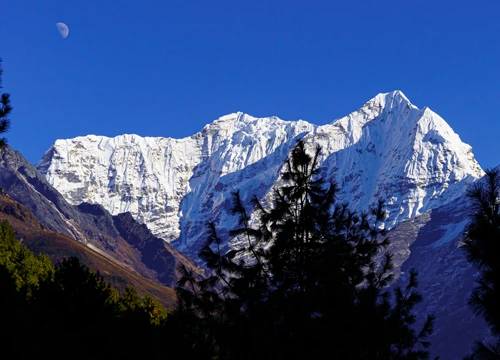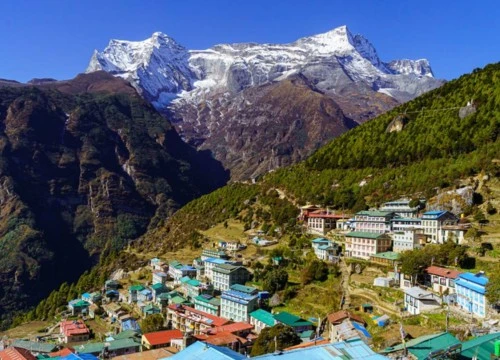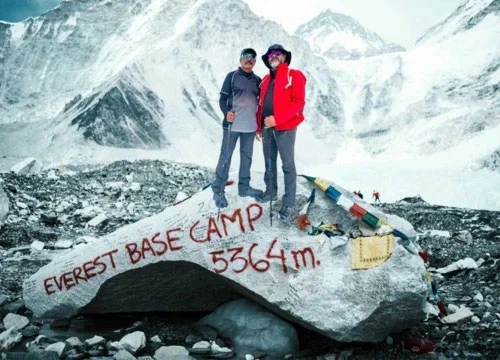Permits Required for Gokyo Cho La Pass Trek
Sagarmatha National Park Entry Permit
Required for all trekkers entering Sagarmatha National Park, which includes Gokyo, Cho La Pass, and Everest Base Camp.
Cost: NPR 3,000 for foreign nationals (~$25 USD)
Issued at: Nepal Tourism Board office in Kathmandu or at the park gate in Monjo.
Khumbu Pasang Lhamu Rural Municipality Permit
A local permit for the Khumbu region to monitor trekking activity.
Cost: NPR 2,000 (~$16 USD)
Issued at: Lukla or Namche Bazaar checkpoints.
TIMS Card (Trekkers’ Information Management System)
Required for safety tracking and trekking registration in Nepal.
Cost: $20 for individual trekkers; $10 for groups
Issued at: Kathmandu or at trekking agencies before departure.
What is the best season/time for Gokyo Cho La Pass?
Nepal has four seasons’ spring, summer, winter and autumn. Among these the best season for Gokyo Cho La Pass trek is during the pre-monsoon (spring) and post-monsoon (autumn) periods.
Spring season, which lasts from March to May is the best time for travelling to Gokyo Cho La Pass trek. During this season the area is covered with vibrant rhododendron blooms, and the weather is usually stable. The sky is clear and the temperatures are reasonable, providing great views of the nearby peaks, including Mount Everest. Trekking is comfortable during this season because of the lovely evenings and moderate daytime temperatures.
Autumn on the other hand lasts from late September to November. Clear, clean skies and mostly steady weather define autumn in the Everest region. Trail conditions are at their driest, and temps are comfortable. The visibility is good and the Himalayan peaks are magnificent to observe during the post-monsoon season.
The Gokyo Cho La Pass trip offers the right combination of clear skies, reasonable temperatures, and good weather in the spring and autumn, making these seasons the best times to tackle the difficult terrain of the Cho La Pass. Trekkers experience the most spectacular views of snow-capped peaks, tranquil Gokyo Lakes, and the famous Everest region as they approach higher elevations and pass through a variety of landscapes.
The lower risk of avalanches and landslides during these seasons is one of the main benefits of trekking. Trekkers may travel more confidently and safely because the trails are sturdy and comparatively dry. Additionally, there are fewer people on the trails during the busiest trekking seasons, making it a more peaceful and private experience.

How challenging is the Gokyo Cho la Pass Trek?
The Everest Cho La Pass Trek is regarded as a difficult expedition, mainly because it requires traversing the extremely difficult Cho La Pass. This journey takes you down a rough trail that winds through several steep and uneven stretches in the heart of the lonely Himalayan region. Furthermore, the journey's constant high altitude can be physically taxing and raise the risk of acute mountain sickness (AMS). Those who are thinking about doing this trek must be in good physical health and fitness.
Those who have hiked at high altitudes before are probably familiar with this level of effort. Still, there's no reason to be overly nervous, not even for first-time hikers. Because hiking days last anywhere from five to seven hours, and because acclimatization is done strategically, the trek seems doable. However, it is best to do a few warm-up treks or stick to a regular workout schedule for a few months before starting the Cho La Pass trip to make sure your body is ready for the challenge.
Is travel insurance required?
Even though insurance might not be required, especially for those doing the Gokyo Cho La Pass Trek, having travel insurance helps reassure other travelers in the event of unanticipated events. This kind of insurance protects against unforeseen circumstances, such as canceled trips, urgent medical attention, and mishaps involving misplaced or pilfered property, among other things. Should you have to postpone your trip or experience accidents while abroad, travel insurance can be quite helpful in paying some or all of the related expenses.
Similarly, it is important to remember that although while theft instances are uncommon, they can nonetheless happen. It is best to keep all valuables hidden to reduce this risk. Additionally, while on the go, travelers can choose to leave their belongings in our office lockers. It is advised that passengers follow their guide's recommendations in the event of any natural disasters in the mountainous areas, such as avalanches, landslides, flooding, or earthquakes. In addition, you must notify your guide right away if you become ill while on the walk.
Chances of Acute Mountain Sickness (AMS) during the trek?
Because of the high altitude of the Gokyo Cho La Pass trip, there is a legitimate risk of developing Acute Mountain Sickness (AMS). As you ascend to greater elevations, your risk of developing AMS rises. Even Gokyo itself is situated at about 4,800 meters (15,750 feet), and the climb often takes you to elevations above 5,000 meters (16,400 feet) as you cross Cho La Pass.
AMS can affect individuals differently, and its onset can depend on various factors, including your individual susceptibility, ascent rate, and acclimatization.
To minimize the chances of AMS, trekkers are advised to follow certain precautions
- Proper Acclimatisation
- Stay Hydrated
- Listen to Your body
- Climb High, Sleep Low
- Consult the professionals
Holiday Tours Nepal Exercise and preparation routine for Trek
Week | Focus areas | Activities | Details | Remarks |
Week 1-2 | Building base for the trek | Cardio, strength and flexibility | Cardio: 3-4 days/week: Brisk walking, cycling, or jogging (45-60 minutes)
Strength: 2-3 days/week: Squats, lunges, step-ups, planks (3 sets of 12-15 reps)
Flexibility: Stretching or yoga (20 minutes after each workout) | Helps to build the base that will help for building endurance and stamina. |
Week 3-4 | Strengthening the Legs | Hiking, Strength, Core | Hiking: 2-3 days/week: Hike on an incline or treadmill (1-2 hours). Start carrying a light pack (5-10 lbs.)
Strength: 2-3 days/week: Squats, lunges, step-ups with weight (10-15 lbs.)
Core: Planks, leg raises, Russian twists (3 sets of 20 reps) | Helps to develop strength and make the legs stronger which will help for the hike during the trek. |
Week 5-6 | Increasing Intensity | Endurance, Weight Training, Hiking | Hiking: 2-3 long hikes (3-4 hours) with weight (10-15 lbs.). Focus on incline and rocky terrain
Cardio: Running or cycling for 45-60 minutes (2-3 times/week)
Strength: Weighted squats, lunges, step-ups, core work (3 sets of 12-15 reps each) | Helps to build further endurance |
Week 7 | Endurance & Simulation | Long Hikes, Full Body Strength | Long Hikes: 1-2 long hikes (5-6 hours) with heavy pack (15-20 lbs.), focus on uphill and varied terrain. Include stairs if possible
Strength: Full body exercises (weighted squats, lunges, step-ups, planks)
Core: 3 sets of planks, side planks, mountain climbers | Helps for building endurance for long hikes and helps for stamina. |
Week 8 | Peak Intensity & Recovery | Simulation, Light Cardio | Simulation: 1 long hike (6-7 hours) with a full pack, focus on staying hydrated and fueled
Cardio: Light running or cycling (30-40 minutes)
Recovery: Stretching, yoga, light walking for flexibility and muscle relaxation | Helps for stretching, flexibility and preparation before and after hike |
Week 9 | Breathing training | Nose and mouth breathing patterns. | Box to box breathing, navy breathing, nasal breathing, belly breathing, 4-7-8 breathing, pursed lip breathing, coherent breathing, bhastrika breathing | Helps for breathing in high altitudes |
Tips for trekkers who are trekking in the Himalayas
Tips for female travelers during periods in the mountains
Know your cycle and pack accordingly sanitary pads, period underwear’s, menstrual cups and tampons.
Pack sanitary pads in case sometimes the dates can be up and down and even someone might need in trek in case you don’t use it.
Bring pain relivers like ibuprofen, heat patches, to ease cramps stay hydrated and eat good nutrition food.
- Wear comfortable and food layered clothing’s rest when needed and mind your mood.
Equipment and Gear List
 General
General
- Four-season (-20 degree) sleeping bag (We provide rental sleeping bags available for an additional USD 35)
- Puffy down jacket (We provide rental jackets for an additional USD 35)
- Daypack (25-30 liters recommended) with rain cover
 Upper Body
Upper Body
- Sun hat or cap (We'll provide you with a trekking cap.)
- Warm woolen hat
- Scarf/Neck Buff (highly recommended to get saved from wind and cold)
- Headlamp or mobile torch light for nighttime
- Polarized sunglasses
 Torso
Torso
- Technical fabric base layer thermals are light for warmer months, heavy for colder months
- Technical fabric t-shirts and sleeve sweaters or high-necks
- Waterproof rain jacket
- Windproof jacket for the walk as it gets windy
- Fleece jacket or down jacket
 Lower Body
Lower Body
- Thermals inner
- Hiking pants at least 3
- Comfortable pants for teahouses
- Waterproof, windproof shell
- Hiking shorts
 Hands
Hands
- Woolen gloves for the tea house
- Hard-shell windproof outer gloves for the walk
 Feet
Feet
- Marino Wool or comfortable, warm socks
- Hiking socks
- Liner socks
- Trekking/hiking boots (waterproof recommended)
- Crampons (For passes)
- Casual shoes or sandals that are comfortable for the time in the tea house
- Gaiters (lightweight for rain and snow)
 Undergarments and Inner Wears
Undergarments and Inner Wears
- Technical fabric/quick drying (can be washed during the trek)
- Sports bras (women)
- Sleeping clothes as per the comfortability
 First Aid Kits and Medications
First Aid Kits and Medications
Note: Our guides carry medications, oxygen cans, and first aid kits during the trip. However, personal kits and medications are recommended.)
- Sunscreen SPF- 50+
- Lip balm or Vaseline
- ointment cream
- Cough Syrup and strepsils (recommended for Khumbu Cough)
- Creams and medicines (for any allergies or diseases)
 Other Essentials
Other Essentials
- Passport
- Extra copies of passport-sized photos
- Reusable water bottle
- Toilet paper, small soap, and shampoo
- Water purification tablets or UV water purifier (if you plan to treat water)
- Water bladder for the day bag
- Small towel for personal use
- Pillowcase in case of allergies to new pillows
- High-protein snacks (such as mountain bars or nuts)
- Waterproof/dry bags for carrying essential documents, stuff, frequently used items, and money
- Power bank or extra batteries
- Cameras and mobile phone
- Cards/book
- Pee bottle/ pee funnel for women
- Trekking poles
- Whistle in case your voice is not loud enough to stop or start
- Thermos for hot water during the nighttime
- We give you a free duffel bag, trekking cap, maps, and t-shirt during your pre-trip meeting in Kathmandu. The duffel bag will be used to pack your trekking supplies.
- For every two participants, we assign one porter. The porter will carry the duffel bag, which should weigh around 10 kg/22 lbs., throughout the walk.
- Daypack bag for daily used stuff like cash, documents, papers, a water bottle or bladder, a camera, toiletries, sunscreen, a notebook, clothing, etc. (with a waterproof cover).
- You can store your luggage (on-trekking items) at the hotel in Kathmandu, and we can assist and help.
- Total luggage for the Kathmandu-Lukla flight is (15 kg/33 lbs.), including duffel (10 Kg/22 lbs.) and backpack (5 kg/11 lbs.)
- A down jacket with a hood(cap) to be warm in altitudes above 3,000m.
- We can provide a down jacket for USD 35. In case of loss or damage, you need to pay back the cost of USD 200 per item.
- We can provide a sleeping bag for USD 35. In case of loss or damage, USD 200 per item must be paid.
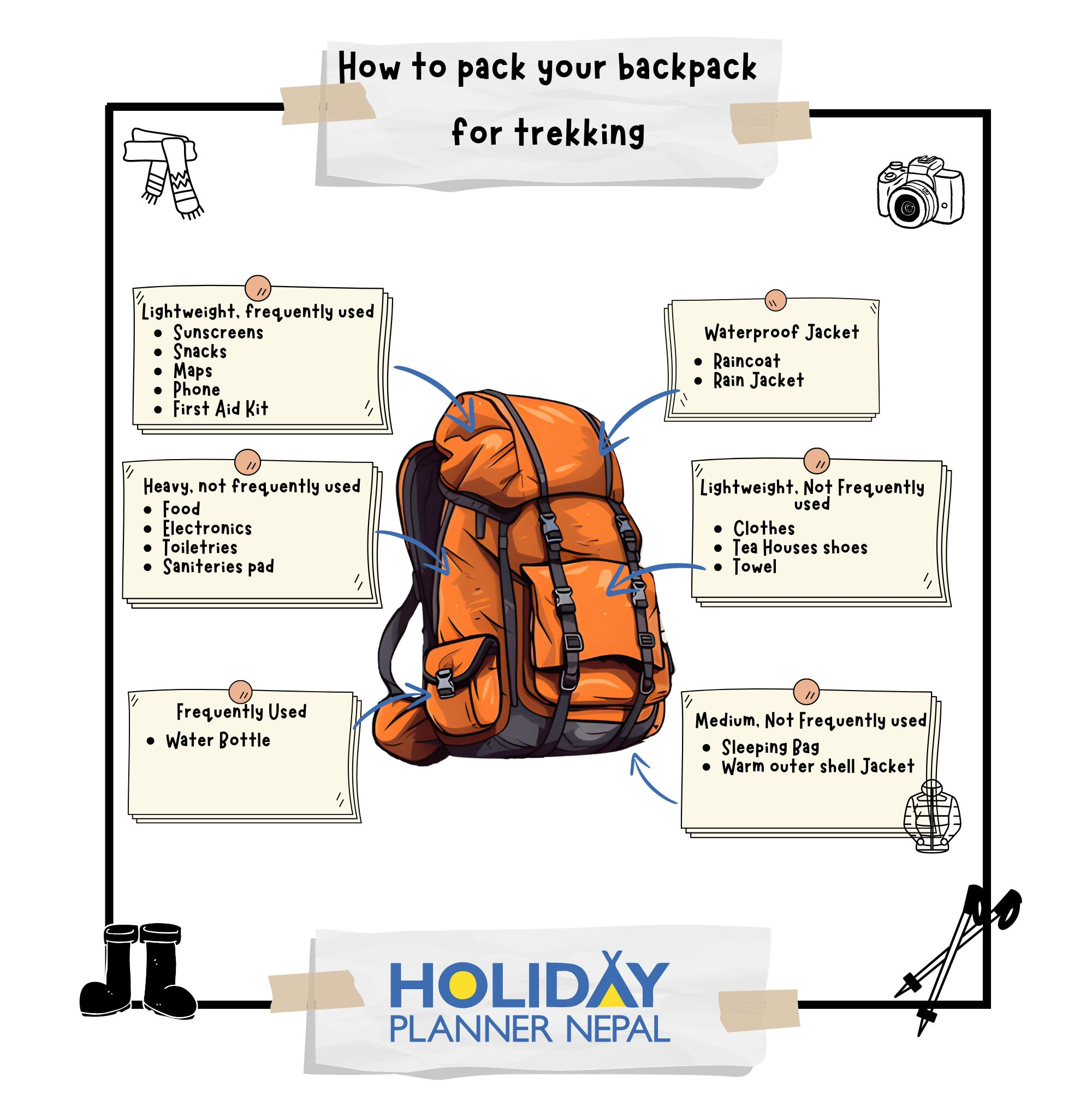
Note: Supplies and gear can be rented or purchased in Kathmandu. Once you are in Nepal, you can buy supplies and gear for hiking if you have spare time. Holiday Planner Nepal representatives will assist you in purchasing the equipment. Thamel a tourist hub, offers a wide range of trekking equipment at affordable prices. Don't wear short clothes inside the monasteries and religious places.
Tips for responsible tourism and respecting local culture at Everest region
- Walk through the left.
- Dress modestly wears long clothes.
- Be polite and engage with the locals with a respect.
- Avoid flashy displays be modest with wealth, technology and the body.
- If someone or someplace deserves a donation show case your love for the community.
- Don't shoot videos and photos inside the monasteries.
- Don't keep your feet over the mantra engraved stones.
- Respect the locals.
- Ask permission before taking pictures.
- Hire the local trekking agencies.
- Buy and support locals by using their local products.
- Avoid leaving trash or any waste behind and carry your waste to the designate bins.
- Avoid the use and throw of plastic bottles on the trail fill up you bottle and throw the bottle in the designated bins.
- Do not pick plants or disturb the wildlife.
- Don’t take things from the nature.
- Limit the use of fire woods and conserve the water. (woods cannot be used for fire)
Charging plug availabe in Nepal
- Use an adapter that uses types D, C, and M.
- Charging costs extra in the mountains, and the cost varies according to the place.
- Bring a power bank of at least 10,000 Mah.
- Leave your power bank on charge rather than the smartphone.
- Phones must be charged at reception where the multiplugs are.

Advantages of planning your trip with us
- Pick-up and drop-off services for all passengers upon international arrival and departure.
- Well-trained, experienced, fluently English-speaking guide, and a strong sherpa or porter for carrying the duffel bag.
- Welcome dinner upon arrival with cultural Nepali dances.
- Three meals a day and tea or coffee during the trek, with accommodation in the mountains.
- First-aid kit box and first-aid services.
- We provide Holiday Planner Nepal’s maps, t-shirt, and cap.
- Down jackets and sleeping bags are available for rent.
- We organize custom services as per the requests of our clients.
- Arrangement of emergency evacuation service (must be paid by the client or insurance).
- We provide an oximeter to check your pulse, oxygen saturation, and heart rate.
- We provide oxygen cans during high-altitude treks.
- We provide SIM cards for travelers, so there won’t be any communication issues.
Conclusion
The Gokyo Cho La Pass Trek is an unforgettable journey through the heart of the Everest region, offering a perfect blend of adventure, natural beauty, and Sherpa culture. From the serene Gokyo Lakes and the challenging Cho La Pass to the iconic Everest Base Camp and panoramic views from Kala Patthar, this trek promises breathtaking scenery at every step. Trekking through remote villages, ancient monasteries, and high-altitude glaciers makes it a truly immersive Himalayan experience.
For travelers looking for an off-the-beaten-path adventure, understanding the Gokyo Cho La Pass Trek itinerary and Gokyo Cho La Pass Trek cost ensures a well-prepared and enjoyable journey.
Ready for the adventure of a lifetime? Plan your trek with Holiday Tours Nepal for expert guides, quality support, and a hassle-free Himalayan experience.
👉 Contact Holiday Tours Nepal today and start your Gokyo Cho La Pass Trek!
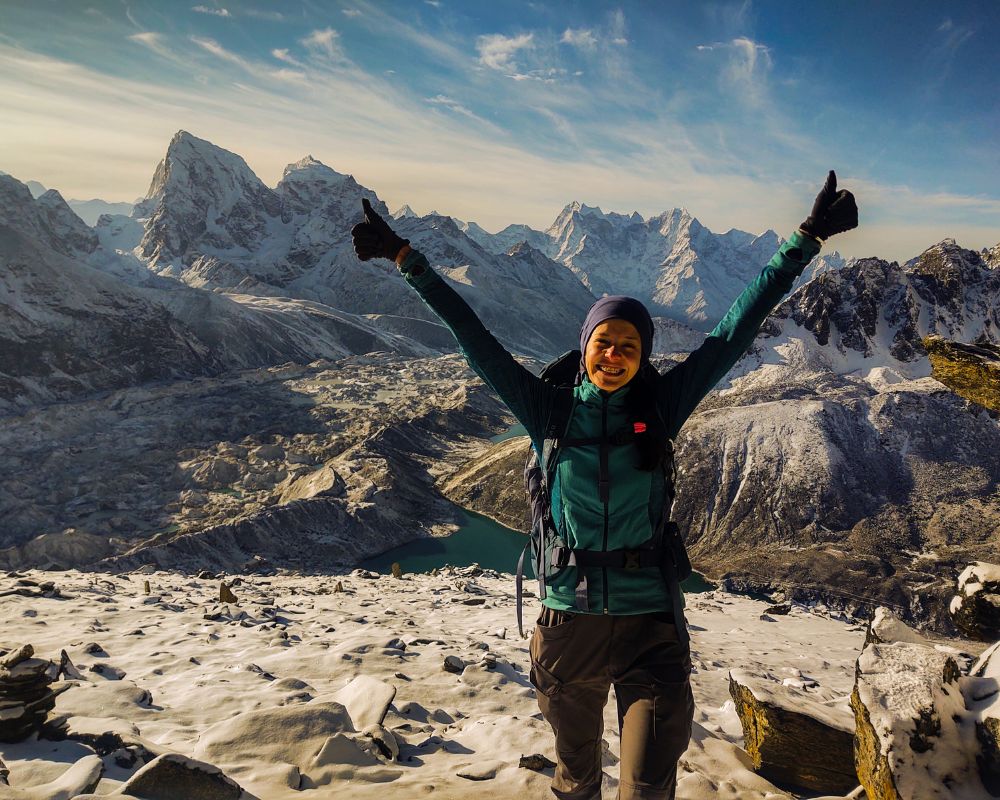


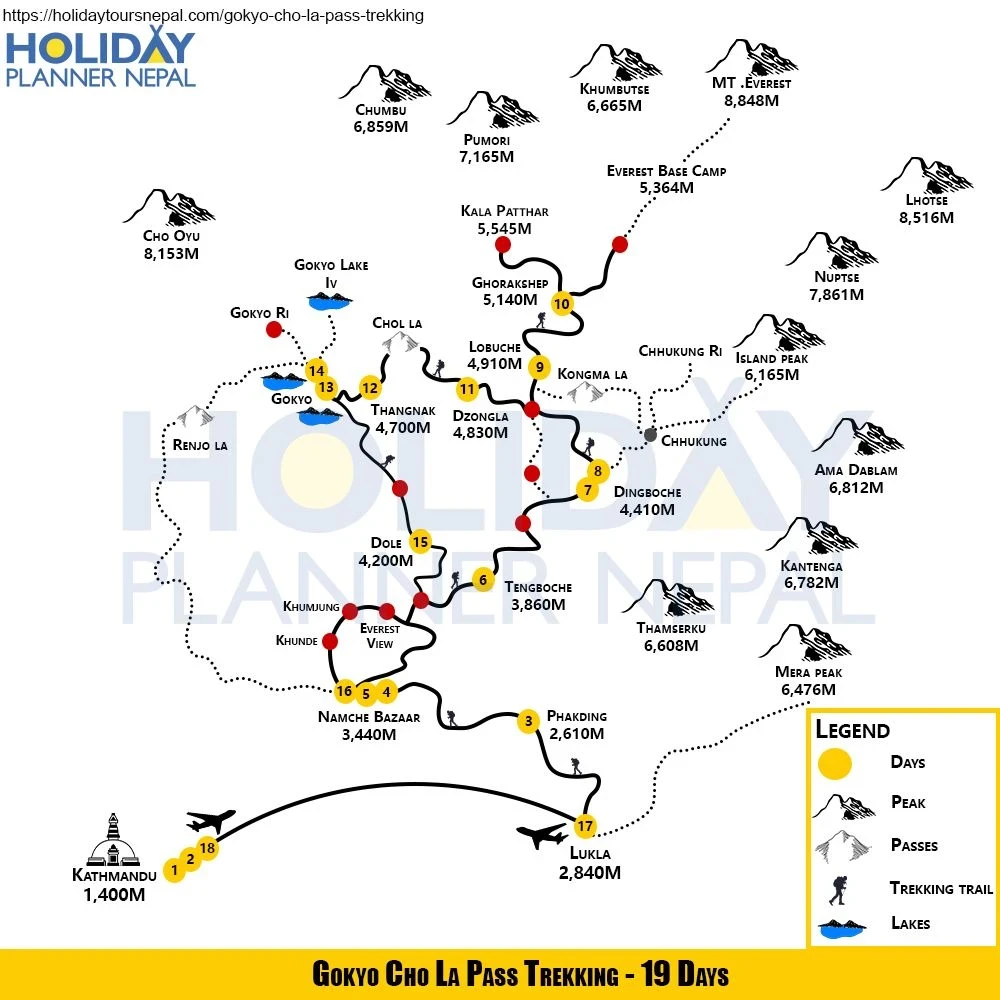


 General
General Upper Body
Upper Body Torso
Torso Lower Body
Lower Body Hands
Hands Feet
Feet Undergarments and Inner Wears
Undergarments and Inner Wears First Aid Kits and Medications
First Aid Kits and Medications Other Essentials
Other Essentials


